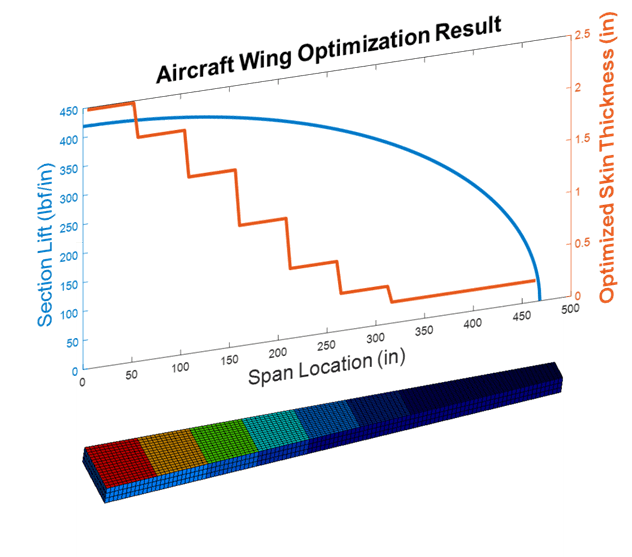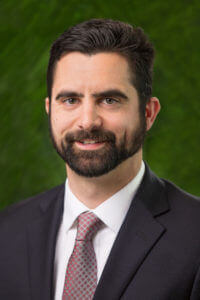Discover how optimization with Simcenter Nastran can improve designs.
Design optimization is an automated process that uses an optimizer to generate improved designs. Simcenter Nastran has built-in gradient-based optimization algorithms for design optimization. This capability can be used to find the optimum design that satisfies requirements, perform tradeoff studies, or update models to correlate with test data. Both traditional design optimization and topology optimization are available with Simcenter Nastran SOL 200, and Femap provides preprocessing capability.
This webinar will start by quickly bringing you up to speed on the fundamentals of design sensitivity and optimization, followed by a brief overview of Simcenter Nastran SOL 200 capabilities. The remaining time, which will be the majority of the webinar, will be spent on three live demonstration problems that incrementally increase in complexity.
Example 1: Sizing a beam cross-section
- Graphical solution based on hand calculations
- Femap with Simcenter Nastran solution
Example 2: Topology optimization of a cantilever structure
- Sigmund 99-line topology optimization reference solution
- Femap with Simcenter Nastran solution
Example 3: Sizing an aircraft wing structure using Femap with Simcenter Nastran
- Many design variables
- Multiple subcase types
For the first two examples, we will show how to use Femap to build both the finite element model and the optimization inputs from scratch, so viewers who wish to replay the webinar later can follow along and fully reproduce the first two examples. We will start with a simple sizing optimization problem that can be solved using hand calculations; the hand calculations will help reinforce the basic fundamentals of design optimization. We will then reproduce the sizing optimization result using Femap and Simcenter Nastran.
 The second example will show how to use Femap and Simcenter Nastran for topology optimization of a cantilever structure. The example can be related to a well-documented problem in the optimization literature. Attendees can experiment with Sigmund’s publicly available 99-line topology optimization MATLAB code to reproduce this example, if interested. The MATLAB approach will not be covered during the webinar, but references will be provided. This example will be followed by a short case study showing how ATA used topology optimization to help design the Transporter/Erector/Launcher (TEL) system for the Antares launch vehicle.
The second example will show how to use Femap and Simcenter Nastran for topology optimization of a cantilever structure. The example can be related to a well-documented problem in the optimization literature. Attendees can experiment with Sigmund’s publicly available 99-line topology optimization MATLAB code to reproduce this example, if interested. The MATLAB approach will not be covered during the webinar, but references will be provided. This example will be followed by a short case study showing how ATA used topology optimization to help design the Transporter/Erector/Launcher (TEL) system for the Antares launch vehicle.
 The final example will demonstrate sizing of an aircraft wing structure using Femap and Simcenter Nastran. This example will demonstrate the capability of Simcenter Nastran SOL 200 to perform optimization on large models with multiple design variables and analysis types.
The final example will demonstrate sizing of an aircraft wing structure using Femap and Simcenter Nastran. This example will demonstrate the capability of Simcenter Nastran SOL 200 to perform optimization on large models with multiple design variables and analysis types.
This webinar will be approachable for anyone with basic finite element analysis experience, and the fundamentals of design sensitivity and optimization will be covered. Femap optimization capabilities were vastly improved starting with Femap 12, and topology optimization was added to Simcenter Nastran SOL 200 (formerly NX Nastran) starting with NX Nastran 12. These are relatively recent updates to Femap and Simcenter Nastran, so even engineers who are experienced with legacy Nastran and Femap optimization features would benefit from this webinar, which will cover these newer capabilities.
About the Speaker:
Anthony Ricciardi, Ph.D., Project Engineer, ATA Engineering Inc.

Dr. Ricciardi is an expert Nastran user and instructor for Siemens’ official course on Nastran Optimization. As an ATA project engineer, he uses Femap and Nastran on a daily basis to deliver analysis-driven solutions to customers’ most challenging engineering problems. He specializes in structural dynamics analysis, aeroelastic analysis, and optimization of aerospace vehicles. Before joining ATA, Dr. Ricciardi worked for the USAF SEEK EAGLE Office, where he implemented aeroelastic analyses, ground dynamics tests, and flight flutter tests for fighter aircraft. As a Virginia Tech graduate student, Dr. Ricciardi developed new optimization methods for aeroelastic-scaled-model design and new analysis techniques for predicting aeroelastic gust response. He worked in aircraft conceptual design and structural design at Cessna Aircraft prior to his graduate studies.